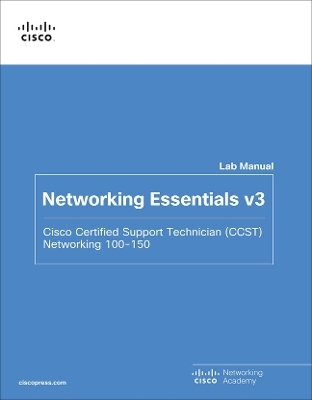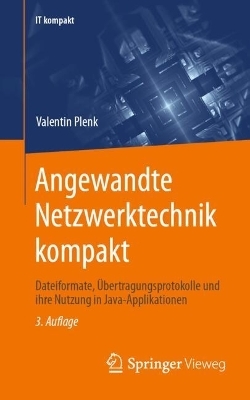
Networking Essentials Lab Manual v3
Cisco Press (Verlag)
978-0-13-829372-7 (ISBN)
The Cisco Certified Support Technician (CCST) Networking certification validates an individual's skills and knowledge of entry-level networking concepts and topics. The certification demonstrates foundational knowledge and skills needed to show how networks operate, including the devices, media, and protocols that enable network communications.
You'll Learn These Core Skills:
Plan and install a home or small business network using wireless technology, and then connect it to the Internet
Develop critical thinking and problem-solving skills using Cisco Packet Tracer
Practice verifying and troubleshooting network and Internet connectivity
Recognize and mitigate security threats to a home network
The 45 comprehensive labs in this manual emphasize hands-on learning and practice to reinforce configuration skills. The Networking Essentials Lab Manual provides you with all the labs and packet tracer activity instructions from the course designed as hands-on practice develop critical thinking and complex problem-solving skills.
Related titles:
Networking Essentials Companion Guide v3: Cisco Certified Support Technician (CCST) Networking 100-150
Book: 978-0-13-832133-8
0-13-832133-7
Cisco Networking Academy is an innovative Cisco education initiative that delivers information and communication technology skills to improve career and economic opportunities around the world. The Academy provides online courses, interactive tools, and lab activities to prepare individuals for information technology and networking careers in virtually every industry.
Chapter 1 Communication in a Connected World 1
This chapter contains no labs or packet tracers.
Chapter 2 Network Components, Types, and Connections 3
This chapter contains no labs or packet tracers.
Chapter 3 Wireless and Mobile Networks 5
This chapter contains no labs or packet tracers.
Chapter 4 Build a Home Network 7
4.4.4. Packet Tracer–Configure a Wireless Router and Clients 7
Chapter 5 Communication Principles 13
This chapter contains no labs or packet tracers.
Chapter 6 Network Media 15
This chapter contains no labs or packet tracers.
Chapter 7 The Access Layer 17
This chapter contains no labs or packet tracers.
Chapter 8 The Internet Protocol 19
8.1.2 Packet Tracer–Connect to a Web Server 19
Chapter 9 IPv4 and Network Segmentation 21
This chapter contains no labs or packet tracers.
Chapter 10 IPv6 Addressing Formats and Rules 23
This chapter contains no labs or packet tracers.
Chapter 11 Dynamic Addressing with DHCP 25
11.2.3 Packet Tracer–Configure DHCP on a Wireless Router 25
Chapter 12 Gateways to Other Networks 29
12.2.2 Packet Tracer–Examine NAT on a Wireless Router 29
Chapter 13 The ARP Process 33
13.1.3 Packet Tracer–Identify MAC and IP Addresses 33
Reflection Questions 35
Chapter 14 Routing Between Networks 37
14.3.3 Packet Tracer–Observe Traffic Flow in a Routed Network 37
14.3.4 Packet Tracer–Create a LAN 41
Reflection Question 43
Chapter 15 TCP and UDP 45
This chapter contains no labs or packet tracers.
Chapter 16 Application Layer Services 47
16.1.5 Packet Tracer–The Client Interaction 47
16.4.3 Packet Tracer–Observe Web Request 49
16.5.3 Packet Tracer–Use FTP Services 51
16.6.4 Packet Tracer–Use Telnet and SSH 54
Chapter 17 Network Testing Utilities 57
17.1.3 Packet Tracer–Use the ipconfig Command 57
17.1.6 Packet Tracer–Use the ping Command 58
Chapter 18 Network Design 61
18.2.3 Lab–View Wireless and Wired NIC Information 61
Reflection Questions 63
Chapter 19 Cloud and Virtualization 65
19.2.3 Lab–Install Linux in a Virtual Machine and Explore the GUI 65
Reflection Question 68
Chapter 20 Number Systems 69
This chapter contains no labs or packet tracers.
Chapter 21 Ethernet Switching 71
21.1.4 Lab–Determine the MAC Address of a Host 71
Reflection Questions 72
21.2.6 Lab–Install Wireshark 74
21.2.7 Lab–Use Wireshark to Examine Ethernet Frames 77
Reflection Question 83
Chapter 22 Network Layer 85
This chapter contains no labs or packet tracers.
Chapter 23 IPv4 Address Structure 87
This chapter contains no labs or packet tracers.
Chapter 24 Address Resolution 89
24.1.9 Packet Tracer–Examine the ARP Table 89
24.1.10 Lab–View ARP Traffic in Wireshark 93
Reflection Questions 99
Chapter 25 IP Addressing Services 101
25.1.8 Lab–Observe DNS Resolution 101
Reflection Question 105
Chapter 26 Transport Layer 107
26.8.1 Packet Tracer–TCP and UDP Communications 107
Chapter 27 The Cisco IOS Command Line 113
27.2.6 Packet Tracer–Navigate the IOS 113
27.3.3 Packet Tracer–Use Cisco IOS Show Commands 118
Chapter 28 Build a Small Cisco Network 121
28.1.4 Packet Tracer–Implement Basic Connectivity 121
28.2.4 Packet Tracer–Configure Initial Router Settings 124
28.3.6 Packet Tracer–Configure SSH 128
28.4.5 Packet Tracer–Troubleshoot Default Gateway Issues 130
Chapter 29 ICMP 133
29.2.6 Packet Tracer–Verify IPv4 and IPv6 Addressing 133
29.2.7 Packet Tracer–Use Ping and Traceroute to Test Network Connectivity 136
29.3.1 Packet Tracer–Use ICMP to Test and Correct Network Connectivity 140
Chapter 30 Physical Layer 143
This chapter contains no labs or packet tracers.
Chapter 31 Data Link Layer 145
This chapter contains no labs or packet tracers.
Chapter 32 Routing at the Network Layer 147
This chapter contains no labs or packet tracers.
Chapter 33 IPv6 Addressing 149
33.4.6 Packet Tracer–Configure IPv6 Addressing 149
33.5.4 Lab–Identify IPv6 Addresses 152
Reflection Questions 155
Chapter 34 IPv6 Neighbor Discovery 157
34.1.4 Packet Tracer–IPv6 Neighbor Discovery 157
Reflection Questions 161
Chapter 35 Cisco Switches and Routers 163
This chapter contains no labs or packet tracers.
Chapter 36 Troubleshoot Common Network Problems 165
36.4.10 Lab–Troubleshoot Using Network Utilities 165
Reflection Questions 169
Chapter 37 Network Support 171
37.2.7 Packet Tracer–Connect a Network Based on a Network Diagram 171
37.2.12 Packet Tracer–Use CDP to Map a Network 174
37.2.13 Packet Tracer–Troubleshooting Challenge–Document the Network 178
Reflection Questions 180
37.4.9 Lab–Verify Address with a Subnet Calculator 182
37.5.3 Lab–Install Wireshark 184
37.5.4 Lab–Use Network Tools to Learn About a Network 186
Reflection Question 193
Appendix A: Allowing ICMP Traffic Through a Firewall 193
37.5.6 Packet Tracer–Troubleshooting Challenge - Use Documentation to Solve Issues 195
Chapter 38 Cybersecurity Threats, Vulnerabilities, and Attacks 199
38.2.11 Lab–Explore Social Engineering Techniques 199
Chapter 39 Network Security 203
39.2.13 Packet Tracer–Configure Access Control 203
39.6.16 Packet Tracer–Configure Basic Wireless Security 207
9780138293727, TOC, 10/9/23
| Erscheinungsdatum | 12.12.2023 |
|---|---|
| Verlagsort | Indianapolis |
| Sprache | englisch |
| Maße | 215 x 275 mm |
| Gewicht | 536 g |
| Themenwelt | Mathematik / Informatik ► Informatik ► Netzwerke |
| ISBN-10 | 0-13-829372-4 / 0138293724 |
| ISBN-13 | 978-0-13-829372-7 / 9780138293727 |
| Zustand | Neuware |
| Haben Sie eine Frage zum Produkt? |
aus dem Bereich


